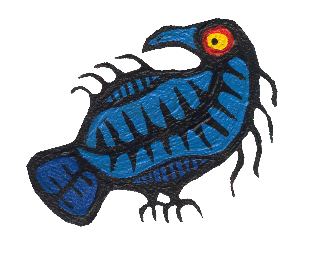Native-Art-in-Canada has affiliate relationships with some businesses and may receive a commission if readers choose to make a purchase.
- Home
- Indian Group of Seven
The Indian Group of Seven
 Morrisseau, Beardy, Janvier, Carl Ray on right, Cobiness, Odjig, Sanchez
Morrisseau, Beardy, Janvier, Carl Ray on right, Cobiness, Odjig, Sanchez After leaving the Free Press, Gary Scherbain opened Wahsa Gallery that specialized in Woodland art.
After leaving the Free Press, Gary Scherbain opened Wahsa Gallery that specialized in Woodland art.The Indian Group of Seven was the moniker Winnipeg Free Press reporter, Gary Scherbain, gave to a group of seven native artists who, in 1973, gave birth to the Professional National Indian Artists Incorporation.
Ten years previously Norval Morrisseau had introduced Ojibwa art to the world. His success inspired other artists to look to their native origins for inspiration to paint memories and imagery that represented their own culture.
Three of those artists were Jackson Beardy, Alex Janvier, and Daphne Odjig. In 1973 they had a group show at the Winnipeg Art Gallery called Treaty Numbers 23, 287, 1171. The numerals were a reference to the numbers given to their respective bands when treaties had been signed with the Canadian government.
The exhibition was ground breaking. For the first time those in the mainstream art world recognized that indigenous modern art was just that...art...not simple scribblings by a simple people.
To follow up their success, the idea came to formalize a group of native artists that would spread the word about native art and assist up and coming younger native artists. Daphne and Jackson Beardy were the main instigators.
But Jackson Beardy, Eddy Cobiness, Alex Janvier, Norval Morrisseau, Carl Ray and Joe Sanchez met in Daphne Odjig's Winnipeg home and discussed common concerns and possibilities for the future. The Professional National Indian Artists Inc, funded by Indian Affairs, grew out of the meeting. Bill Reid of the Haida nation didn't officially sign on at the time, but participated in some group shows later.
Joe Sanchez, a native American, who was in Canada to escape the draft, was included because Daphne and her husband Chester Beavon had taken him under their wing.
Eddy Cobiness was an avid member and it was he who had introduced John Denighy (organizer of the Winnipeg Art Gallery show) to the others.
After the success in Winnipeg, John Denighy and someone from Indian Affairs helped organize three more shows. Daphne recalls the first was at the Wallach Gallery in Ottawa and was followed by a show in Vancouver. The last show featuring the group as a whole was at the Dominion Gallery in Montreal in 1975.
The Indian Group of Seven Influenced a New Generation
I haven't been able to find information that confirms that the group, under the banner of the PNIA, organized any activities that directly benefited young native artists but as individuals some of the group members did so.
Jackson Beardy opened a school for First Nations artists and Daphne and Carl Ray taught at the Manitou Arts Foundation on Shrieber Island during the 1970's and some of those students became the second generation of Woodland artists and are continuing to impact the Canadian native art world.
Although it had a short life and never expanded to include other native artists like Arthur Schilling or even Goyce or Josh Kakegamic in Red Lake, that the Indian Group of Seven existed at all was a critical first step in the development of the concept of Indian art as a part of the Canadian art cultural scene.
Even throughout the 1980's curators and artists were still arguing about whether contemporary native art was a function of the prehistoric/early historic works in museums or whether it had a place in mainstream galleries. For example, in 1989 when the Vancouver Art Gallery produced an exhibition entitled "Beyond History" it specifically named the art of the Canadian Woodland School as 'tribal'.
The Professional National Indian Artists Inc. eventually ceased to exist as an organization as the individual members concentrated on developing their own careers. But they had cleared the way for another generation of Anishnaabe artists.

The Indian Group of Seven Influence
The influence that the Indian Group of Seven made on the development of native art in Canada showed up first on Manitoulin Island, home to Daphne Odjig.
Although the training, lifestyles and creative motivation of contemporary native artists differ profoundly from their ancient counterparts, today's Woodland Art is sourced by traditional artistic representations used by prehistoric Eastern Woodland Indians.
Woodland Art and Cultural Revitalization
To understand the influence of the contemporary Woodlands School it's worthwhile taking a look at how art revitalized Eastern Woodlands Indian culture in prehistoric times
Other Native Artists
Why the Ojibwa feature so prominently in this discussion of First Nations' art.





